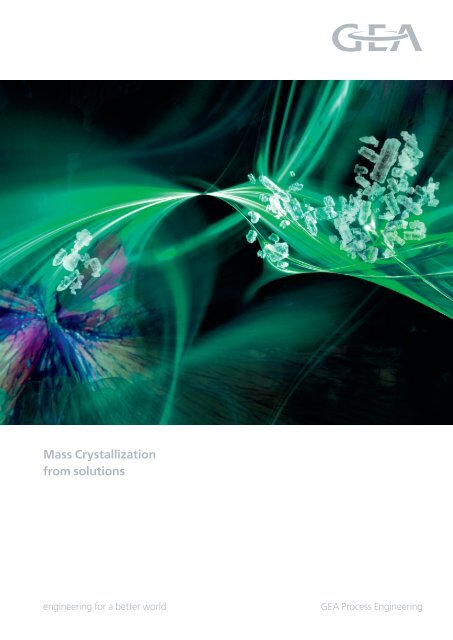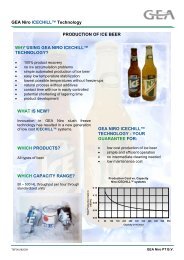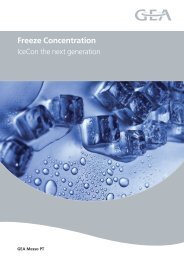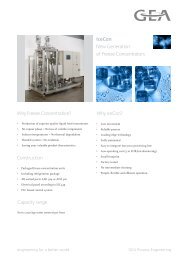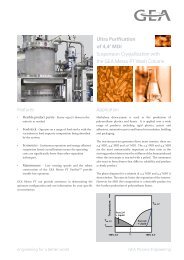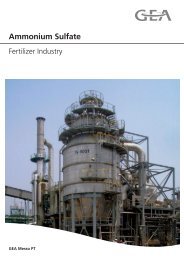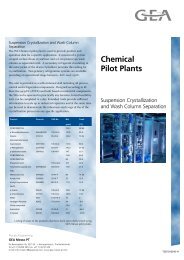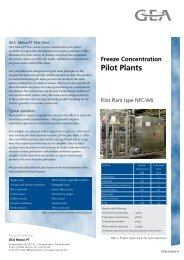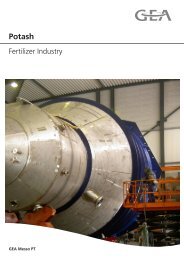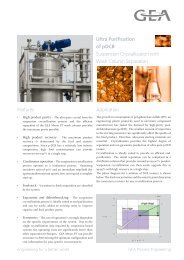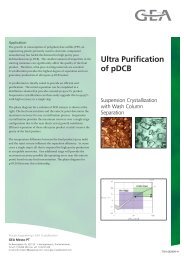Mass Crystallization from solutions - GEA Messo PT
Mass Crystallization from solutions - GEA Messo PT
Mass Crystallization from solutions - GEA Messo PT
- No tags were found...
Create successful ePaper yourself
Turn your PDF publications into a flip-book with our unique Google optimized e-Paper software.
Range of ProductsIndividual plants for the chemical, pharmaceutical and food processing industries(Unit operation, evaporation, crystallization, thermocompression)— <strong>Crystallization</strong> plants— Evaporation plants (for concentration of <strong>solutions</strong> prone to formation of scaling)<strong>Crystallization</strong> and evaporation technologies for the chemical, pharmaceuticaland food processing industries, e.g.:(Entire technology concepts, based on precipitation, evaporation, crystallization)— Common salt production plants— Reaction crystallization plants for several base/acid reactionsPlants for environmental protection(Based on precipitation, evaporation, crystallization)— Pickling bath liquor recycling plants— Landfill leachates concentration plants— Industrial waste water ZLD plants— Treatment plants for slags <strong>from</strong> the secondary aluminum industriesWe know how!3
<strong>GEA</strong> <strong>Messo</strong> <strong>PT</strong> is a leader in its field through in-depth reviews of its operating installations andresearch and development. The Research and Development Department of <strong>GEA</strong> <strong>Messo</strong> <strong>PT</strong> ishoused in a three-hundred-square meter facility, equipped with test units that simulate batch andcontinuous operation of all basic types and configurations of crystallizers. It has in-house analyticalcapabilities for direct determination of concentration, supersaturation, and other physicalproperties of the subject process liquors. Not only the design of crystallizers but the developmentof optimized separation processes for our clients’ needs is in the focus of <strong>GEA</strong> <strong>Messo</strong> <strong>PT</strong> chemistsand engineers.<strong>Crystallization</strong> in History and PresenceIn antiquity, settlements developed around, and exploited sites where salt was easily available,whether as rock, brine, or derived <strong>from</strong> solar evaporation. For example, salt was produced inthe Pharaonic Egypt at the Nile Delta; similarly, the Romans recovered salt at Ostia seacoast(near Rome) and the same happened all over the world (e.g. in China). These and many other productionsites prove that crystallization <strong>from</strong> solution is one of the oldest unit operations practicedby humankind.While crystallization in solar ponds is still in regions with plentiful sunshine, its low productionrate and mediocre product purity prevents this technology to be used generally. As the worlddeveloped through industrial age, the demand for crystalline chemicals increased in variety, quantity,and quality. This led to the birth of crystallization technology that aimed at improving themethods and equipment used in crystallization operations. Modern crystallizers can boost specificproduction rates that are several orders of magnitude higher than solar ponds, have low manpowerrequirements, and low production costs.The specific requirements of a crystallizer can vary widely, depending on the nature of the product,and its intended use: pharmaceutical and food products require higher purity, for example,while fertilizers need larger crystal size; the crystal size and final moisture are not as important incrystallization systems which produce an intermediate compound. There are cases where the realproduct of the crystallizer is the solvent: crystallization is used to separate <strong>from</strong> the solvent thecompounds that make it impure. Further, there are cases where crystallization is used to concentratea solution, by crystallizing and removing the solvent (freeze concentration). One quality thatis present in all crystallization systems, regardless of the final use of the solvent or the crystal, isthe ability to separate the crystals <strong>from</strong> the mother liquor. This ability is a function of the crystalsize, and, by extension, a function of the separation equipment that can be used. Centrifugation isby far the most efficient separation method, if the average crystal size is large enough. It is thereforelogical to expect that of the characteristics of a crystallizer, the crystal size it produces is ofgreat importance. The possible crystal size of a given compound is dependent on its chemical andphysical properties, and those of the solution in which it is dissolved. In parallel, the crystal sizeis dependent on the equipment used to crystallize it, and the method by which the equipment isoperated. The crystallizer used can contribute to improving the crystal size, within physical andenergy boundaries, by controlling the nucleation, the attrition, and the growth rate of crystals, andby destroying a fraction of the smaller crystals present in the crystallizer itself. Inattention of theseparameters, on the other hand, can contribute to a degradation of the crystal size.– A 16th century salt works5
Peripheral ComponentsThe crystallizer is the heart of a crystallization system, but there are several components, in theperiphery, that need to be considered before the final product can be collected. The suspension<strong>from</strong> the crystallizer has to be separated, the crystals have to be dried and packed. The vapourshave to be condensed and the non condensables to be extracted by vacuum pumps. Fig. 8 showsa simplified flow sheet of a complete crystallization plant operated on the principle of evaporativecrystallization under vacuum. Depending on process considerations (crystal size, evaporative duty,etc.) one of several types of crystallizer can be installed instead of the FC crystallizer shown, includingmultiple-effect units. Instead of using steam for heating (as shown), one could utilize mechanicalor thermal vapour recompression. In the illustration, the vapours <strong>from</strong> the (last) crystallizerare condensed in a surface condenser; however, a mixing condenser could be chosen, instead.The suspension in the crystallizer can be withdrawn by overflow, as shown, or pumped out, usingpumps with special specifications. Because suspension densities are usually between 15 to 25%wt.in the crystallizer, while a centrifuge operates best at 50 to 60%wt. suspension, the suspension ispreconcentrated in thickeners or hydrocyclones. The underflow of the thickener or hydrocycloneis sent to the centrifuge for separation.Depending on the product CSD (and to a lesser degree on the physical properties of the suspension)there is a choice between types of centrifuges: generally, the decanter and peeler are used forsmaller particles, and the screen bowl and the pusher for larger particles. In some cases of verysmall particle sizes or very fragile crystals, filters are used, instead of centrifuges. Filters, however,are usually not as efficient as centrifuges in separating the solvent <strong>from</strong> the crystals. The smallamount of residual solvent left on the crystals after the separation step, is removed in a dryer. Thereare several types of dryers that are used, depending on crystal size, crystal chemistry (reactivenature, tendency to decompose, oxidize, etc.), crystal fragility, and initial solvent content. The mostcommon types of dryers used are fluid bed (stationary or vibrating), and the flash dryer.steamcooling watercrystallizerprethickenercentrifugedrierfeedproductFig. 8 Simplified flow sheet12
Application Examples– Details <strong>from</strong> a picking bathliquor regeneration unitThe selection of equipment and the design of a crystallization operation is dependent on, andinfluenced by several process-specific factors. The following examples illustrate how these factorsinfluence the choice of crystallizer type:Surface Cooling <strong>Crystallization</strong>Surface cooling crystallization will be selected if the solubility of the substance to be crystallizedis strongly dependent on temperature, and if vacuum cooling crystallization cannot be chosen, e.g.the vapour pressure required to achieve the endpoint temperature is too low for the plant utilities,or too expensive.Vacuum Cooling <strong>Crystallization</strong>Vacuum cooling crystallization is usually chosen if the solubility of the substance to be crystallizedis strongly dependent on temperature, and if the vapour pressure of the solvent is high enoughfor this application to allow the use of conventional vacuum equipment. Vacuum cooling crystallizationis the preferred cooling crystallization method for continuous operation conditions, due tothe fact that the supersaturation is generated by adiabatic cooling of the solvent at the liquor level.This means that the energy is removed <strong>from</strong> the crystallizer at a location that is far less prone to encrustations,and with a method that requires far less mixing energy input to the crystallizer slurry.– Loop crystallizer for applications insurface cooling crystallization– Spin bath regeneration plant13
Vacuum Cooling <strong>Crystallization</strong> of Potassium Chloride (Hot Leach)This example in Fig. 9 shows the recrystallization of potassium chloride in industrial grade <strong>from</strong>fertilizer quality. The crude KCl is dissolved at elevated temperatures in a recycled stream ofmother liquor. The resulting solution, now saturated with potassium chloride, is fed to a multiplestage,vacuum cooling crystallizer train. In order to fulfil the requirement of coarser crystals,the type selected is the DTB crystallizer. Fines dissolving is possible, by adding water to eachcrystallizer’s clear liquor overflow. The number of stages is optimized on the basis of maximumheat recovery (the recycled mother liquor is reheated in condensers using the vapours leaving thehotter crystallizers). Barometric (direct-contact) condensers are usually employed, so that the watercontent of the mother liquor is increased, and thus its dissolving capacity is improved. Steam isused (in separate heat exchangers) to heat the recycled, and diluted, mother liquor to the temperaturerequired by the dissolver step, and the loop is closed by returning the mother liquor to thedissolver. The crystals are separated in pusher centrifuges, washed and dried. The typical crystalsizes averages are 0.8 to 1.0 mm.– Vacuum evaporators forbrine concentrationhot dissolving station filtration crystallization and recovery separtion and drying station silocooling brinecompressed airprocess watercrude kcisteamsteamcondensateto boilerhouseFig. 9 Potassium chloride refinery for industrial grade quality, triple-effect vacuum cooling crystallizationRecovery of Pickling Bath Effluent LiquorsVacuum cooling crystallization can also be used to purify <strong>solutions</strong>, by crystallization of the solute.The pickling of mild steel sheets with sulfuric acid produces an aqueous waste stream containingferrous sulfate and sulfuric acid. Cooling of that solution forces ferrous sulfate to crystallize asFeSO4.7H2O. From the viewpoint of the mother liquor composition, this is a way to purify thesolution. At the same time, the seven molecules of water that is removed with the crystallizedferrous sulfate causes the reconcentration of the sulfuric acid. The solution thus treated can be recycledto the pickling bath. The vacuum cooling is achieved in a single-effect draft-tube crystallizerwhich is operated together with a high-vacuum generator (a steam ejector or chilled water surfacecondenser). This modern process may be operated for a couple of months without interruptionsfor washouts.– Details <strong>from</strong> a picking bath liquorregeneration unit14
Evaporative <strong>Crystallization</strong>Evaporative crystallization is usually a process that is conducted under vacuum, just like the vacuumcooling crystallization. This process is chosen when solubility of the solute is nearly independentof temperature. As in vacuum cooling crystallization, special scaling problems are not aserious problem as long as boiling on the heater surface is avoided, and the special case of inversesolubility (solubility decreases with temperature) is recognized and taken into consideration.<strong>Crystallization</strong> of Sodium ChlorideThis example in Fig. 10 shows a crystallization plant for table salt, operated with concentratedbrine <strong>from</strong> a solar pond. In addition to three FC crystallizers, there is an OSLO crystallizer, used bythe plant to produce a fraction of its output as coarse crystals. The plant is operated as a quadrupleeffectunit. The coarse crystals <strong>from</strong> the OSLO are separated on a pusher centrifuge, whereas thesalt produced in the FC crystallizers is separated on screen bowl centrifuges, after being countercurrentlywashed with fresh feed liquor in a washing thickener. The product crystals are driedand packed. In order to maintain the level of impurities in the system to an acceptable level, somemother liquor is removed as hydrocyclone overflow, and purged. Some plants of this type havebeen supplied for the production of up to 2.5 t/h coarse (mean size greater than 2 mm) salt andadditionally 10 t/h of normal salt.Fig. 10 Salt recovery <strong>from</strong> solar brine with OSLO crystallization15
Modern Applications in Environmental ProtectionFlue Gas Desulfurization (FGD): Scrubber EffluentConcentration of scrubber effluents <strong>from</strong> FGD systems in thermal Power Plants has been practicedfor about four decades. Plants for concentration of these wastewaters to dryness (ZLD) are in factevaporative crystallization units, but should not be designed as simple evaporation units. Usually,FGD concentration units are combined with pre-treatment facilities, such as heavy metals precipitation,in order that it may be possible to recover a brine or a product salt pure enough for re-use.A typical installation for the zero-liquid-discharge (ZLD) of the liquid effluent <strong>from</strong> a flue gascleaning system in garbage fired power station consists of a heavy metals precipitation and adouble-effect evaporative crystallization unit, with two FC crystallizers supplied to recover sodiumchloride or calcium chloride dihydrate salt. In the case of Calcium chloride the first stage is a gypsum-seededpre-concentrator, and the second stage is the calcium chloride crystallizer. The crystalproduct is separated on a screen bowl centrifuge, dried, packed and reused in another industrialapplication.– Wastewater ZLD plant for the liquideffluent <strong>from</strong> FGD in a garbage firedpower stationRecovery of CaffeineWhen caffeine is extracted <strong>from</strong> coffee by the supercritical carbon dioxide method, a caffeine containingwaste water is produced. Evaporation, combined with a surface cooling crystallization separatesthis waste water into a caffeine of food grade quality, and pure distillate which can be reusedfor the decaffeination process. Short residence times at the higher temperatures is important inthe evaporative step of this process, in order to minimize caffeine decomposition. The processencompasses active carbon treatment used to remove impurities that influence the product colour,followed by a two-stage falling film evaporator driven by process vapours compressed to a higherpressure by a single mechanical compressor. In order to minimize residence time in the evaporators,the final concentrate is produced in a separate, smaller unit. This concentrate is finally cooledto ambient temperature in a surface cooled loop crystallizer, to crystallize caffeine monohydrate.The crystals are calcined to remove the water of hydration, and packed. This caffeine product isused in the manufacturing of soft drinks.– Typical needle-shaped Caffeinemonohydrate crystal16
Salt <strong>from</strong> Secondary Aluminum SlagWhen aluminum scrap is molten down, the liquefied aluminum must be protected <strong>from</strong> exposureto the atmosphere to avoid its oxidation. This protection is provided by a layer of molten sodiumchloride / potassium chloride that float over the aluminum. This salt remains as slag after the recoveryof the aluminum. This slag is very reactive. Humidity causes evolution of poisonous andexplosive gases, the leachate is saturated with salts. Consequently, processes had to be developedto solve this environmental problem. The slag is fed to a cascade leaching process to achieve degassingunder controlled process conditions and to dissolve the salts. The gases evolved are fed toan incinerator that allows the plant to recover the combustion energy. The remaining residue isseparated <strong>from</strong> the salt solution by filtration and given to landfill. The solution is fed to a MVRdriven evaporative FC crystallizer. The mixed salt product is separated, dried and reused in thesame process).Ammonium Sulfate <strong>from</strong> the Caprolactam ProcessAmmonium sulfate is a by-product of the synthesis of caprolactam. Multiple-effect evaporativecrystallization is the well-established process to recover crystalline ammonium sulfate and marketit as fertilizer. In the last few years, the fertilizer marketplace has seen an in-creased demand forlarger crystals, and for a narrower size distribution.The example that follows shows a triple-effect evaporative crystallization plant using DTB crystallizersfor the production ammonium sulfate of an average crystal size of ≥ 2 mm. The solutionis fed counter-currently in order to im-prove crystal growth conditions by combining the highestprocess temperature and highest impurity concentration. The <strong>Messo</strong> DTB crystallizers use bottomentryagitators, which provide superior mixing characteristics at a lower power requirement thancommon agitators. The product crystal size is enhanced by fines destruction systems. Each DTBcrystallizer discharges slurry to a common slurry collection tank. The slurry is then fed to pushercentrifuges, where the crystals are washed and separated <strong>from</strong> the mother liquor. The centrifugedcrystals are dried and screened, and the undersize fraction is recycled for recrystallization.– Triple-effect four stage evaporationcrystallization of ammonium sulfatein DTB (caprolactam process)with after-crystallization (FC)17
Research and Development ServicesChemical laboratory andPilot Plant FacilitiesThe <strong>GEA</strong> <strong>Messo</strong> <strong>PT</strong> chemical laboratory and pilot plant facility is available to develop thebasic information necessary for the design of crystallization plants as well as the mostappropriate overall processes for our clients. The chemical laboratory is able to define physicalproperties to the crystallizer designer, such as the metastable zone width (supersaturation),desupersaturation rates, viscosity, density of a range of compositions, the system solubility, formationof mixed crystals, as well as the chemical compositions of <strong>solutions</strong> and minerals.Our research and development facility has equipment that accurately represents most types ofcrystallizers, and this is used as necessary to simulate the specific design envisioned for our clients.These process designs can be tested in small pilot plants brought together according to the specificprocess requirements, and samples can be produced for further (market) tests. In case of productsthat are too sensitive to be shipped to our facility, or that require special handling (due to safety orhealth concerns) our team may perform the necessary tests or investigations in our clients’ facilities.We are proud to have developed and optimized production processes for the chemical, pharmaceuticaland food industry jointly with our customers and tailor-made for the individual project.We continue to improve – for the benefit of our customers.18
Our Product ExperienceAmong a lot of others <strong>from</strong> A to Z:Acetylsalicylic acid & saltsAdipic acidAmmonium bromideAmmonium dimolybdateAmmonium hydrogenfluorideAmmonium sulfate (also by reaction)Ammonium thiosulfateAscorbic acid & saltsBenzoic acid & saltsBisphenol ACaffeineCalcium chlorideCalcium formateCalcium tartrateCarnalliteCitric acid & saltsCooling Tower BlowdownCopper chlorideCopper sulfateDextrose (Glucose)DichlorobenzeneDicyandiamideDipentarythritolEpichloro hydrine processeffluent ZLDFerrous sulfate <strong>from</strong> process effluentsFerrous sulfate <strong>from</strong> TiO2Fumaric acid & saltsGlutamic acid & saltsGuanidine nitrateHexachlorocyclohexaneIsomaltuloseKetogulonic acid & saltsLactic saltsLactoseLandfill LeachateConcentration & ZLDLauryllactamMagnesium ammonium sulfateMagnesium chlorideMagnesium hexafluorosilicateMagnesium sulfateMalic acid & saltsMethionineNickel acetateNickel nitratePentaerythritolPotash <strong>from</strong> various sourcesPotassium bromidePotassium carbonatePotassium chloratePotassium chloridePotassium dichromatePotassium hydrogencarbonatePotassium nitratePotassium permanganatePotassium phosphate (Industrial)Potassium sulfatePotassium sulfate <strong>from</strong>Na2SO4 & KCl (conversion)Salicylic acid & saltsSalt (based on sea saltrespectively brines)Silver nitrateSodium acetateSodium ascorbateSodium carbonateSodium chlorateSodium chloride <strong>from</strong> sea saltSodium chromate (& Na2SO4)Sodium cyanideSodium dichromateSodium disulfiteSodium dithioniteSodium fluoride saltsSodium formateSodium glutamateSodium ketogulonateSodium nitrite (waste)Sodium perborateSodium perchlorateSodium phosphates (industrial)Sodium salicylateSodium sulfateSodium tartrateSodium thiocyanateSorbic acid & saltsSulfanilic acid & saltsTartaric acid & saltsTM<strong>PT</strong>rimellitic acidUreaVinasse evaporationYeast effluent processingZinc sulfate 6-hydrateZinc sulfate 7-hydrate19
Excellence Passion Integrity Responsibility <strong>GEA</strong>-versity<strong>GEA</strong> Group is a global mechanical engineering company with multi-billion euro sales and operationsin more than 50 countries. Founded in 1881, the company is one of the largest providers ofinnovative equipment and process technology. <strong>GEA</strong> Group is listed in the STOXX Europe 600 Index.<strong>GEA</strong> <strong>Messo</strong> <strong>PT</strong><strong>GEA</strong> <strong>Messo</strong> GmbHFriedrich-Ebert-Straße 134, 47229 Duisburg, GermanyPhone: +49 2065 903 0, Fax: +49 2065 903 199info.geamesso.de@gea.com, www.gea-messo-pt.com<strong>GEA</strong> Niro <strong>PT</strong> B.V.De Beverspijken 7b, 5221 EE ‘s-Hertogenbosch, The NetherlandsPhone: +31 73 6390 390, Fax: +31 73 6312 349sales.niropt.nl@gea.com, www.gea-messo-pt.com© <strong>GEA</strong> Group AG. All rights reserved. Hil maxim fuga ut dunt delis dis simetur. 05/2012


